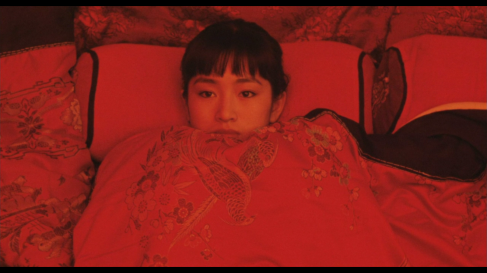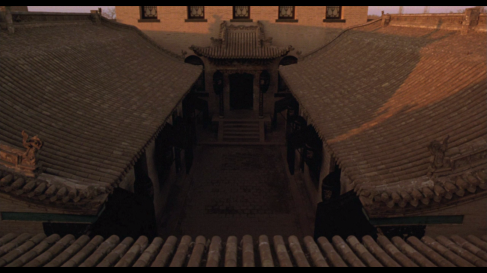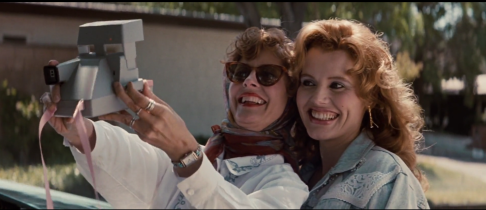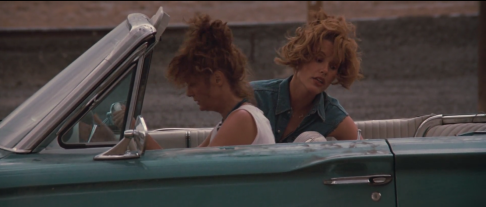
Hot Fuzz (Edgar Wright, 2007)
It’s been the subject of much heated debate that cinephilia has increasingly populated the world of film (perhaps this is why there’s been so many remakes, reboots, spin-offs and sequels lately). Whether this is a good or bad thing for new films, it’s certainly a field to be approached, and it has in the works of several directors who showed their passion for the overlooked pleasures of certain films. The leading filmmaker reaching back to “trash” cinema, as Pauline Kael would call it, has been Quentin Tarantino, but he’s not alone.
Edgar Wright, the British director of deliriously flashing parody comedies, is one of the major figures in this revision of popcorn film conventions, and Hot Fuzz is his homage to the cop features that have so gracefully filled our screens with explosions and catch phrases. In glorious scenes bursting with quick cuts, spinning cameras, good-cop / bad-cop relationships and predictable plot twists, Wright and his faithful team – which includes producer Nira Park, Simon Pegg and Nick Frost – create a thrilling, awesome parody of action movie clichés while admiting the guilty pleasure that films like Point Break and Bad Boys II bring to their audiences (yes, even Michael Bay gets some love here, although there are also references to more polished classics like Chinatown and The Wicker Man). But unlike many of them, Hot Fuzz comes with one surprisingly funny surprise after the next, including self-references and the whole lot. Not to miss if you believe cool guys don’t look at explosions.

Furious 7 (James Wan, 2015)
Over-the-top doesn’t begin to describe the seventh installment of Fast and Furious. The notion of top has been smashed, crashed, burned, shot at, punched in the face and ran over with a bullet-proof car-tank. It doesn’t even exist. And honestly, we can only thank it for doing that, because the middle ground wouldn’t have sufficed. Furious 7 has a bigger cast (including Jason Statham, Kurt Russell, Djimon Hounsou and… Tony Jaa?), bigger effects, bigger stunt sequences and bigger ambitions, and the result is a fistful of fun. It proves that action films work strictly in two distinct ways: you keep it real and clear, or you blow up cars with helicopters.
The film, bound to be the year’s top grosser if the second Avengers doesn’t get in the way, still has features that don’t do justice to its greater moments, most notably the open sexism of the street races and the plot holes in the logistics, but it is, without a shadow of a doubt, an alternate example of the escalation of the absurd that Hot Fuzz loves so much. It’s the best film Michael Bay never did, and in its sincere interest in multiculturalism, it’s a much more respectable achievement. And, sincerely, a film with Vin Diesel, The Rock, Jason Statham, Tony Jaa and Kurt Russell, with actual visual clarity and actual bad-ass one liners? Good enough a dumb-awesome movie for me.

Ong Bak: Muay Thai Warrior (Prachya Pinkaew, 2003)
Ting (Tony Jaa) is a villager from Ban Nong Pradu who offers himself as a candidate to rescue the head of the village’s Buddha statue. Soon before the head is taken, he’s reminded by his master of the responsibilities that his powerful skills require, as they might get him in danger and possibly hurt others. When he gets to the city, he, well, gets in danger and kills and severely injures others, directly and indirectly, showing little to no remorse. It happens, I guess.
That could just be the same innocence typical of most martial arts films, but Ong Bak, for being more serious than the average, has this flaw too exposed for its own good. The films too full of action movie clichés and stereotypical character, and it’s not until its final sequence that we actually get to marvel at Tony Jaa’s incredible set of skills. The rest feels too forced in its slow motion sequences and instant replays, and the choreography feels too out of touch with the rest of the story, as if they went for whatever tested his limits better. Since there’s not much of a story and the fighting takes too long to get really good, the film is something of a disappointment.

Mad Max (George Miller, 1979)
Perfect car stunts, endless blue skies and young Mel Gibson’s butt shine in Mad Max, George Miller’s violent, stylish film debut. Until 1999’s The Blair Witch Project, it was the film with the highest profit-to-budget ratio of all time, and for very good reasons: if the overly dramatic musical cues, the dystopian setting and the wild vocabulary of the film (the bandits often feel like an evolution of the droog system from A Clockwork Orange) screams cult classic, its gorgeous landscapes, iconic performances and depth-friendly, entrancing camerawork suggest the skills of a professional director, and a great one. The Mad Max franchise, which will have a new sequel this summer starring Tom Hardy, started with an energetic film with violence that verges on amorality but is always massively compelling.

The Rock (Michael Bay, 1996)
I couldn’t help but think of Tony Zhou’s enlightening video essay about Michael Bay’s directorial style every single minute of The Rock, probably his masterwork but still a disappointing experience. In his essay, Tony nails down the problem with the visual style behind every one of his films, and The Rock is no exception. Set in San Francisco, the film tells the story of Stanley Goodspeed (Nicolas Cage), a biochemist who works for the FBI and is summoned for the biggest mission of his life: alongside ex-con John Mason (Sean Connery), he must stop a group of rebel soldiers in their blackmail operation against the country, otherwise they will blow up San Francisco with V/X gas, said to be more powerful than napalm and incredibly deadly. But if the demands of the rebels (and the hostage situation they impose) give the film a thought-provoking tone, Bay sacrifices it by dealing with the topic with kid gloves.
It took me about two minutes to foresee everything I could expect from the film: right from the opening credits there is a massive cluster of information and visual elements, but this overblown abundance of material doesn’t work here; there is so much going on nothing stands out very well. Every scene is pumped to the maximum volume, every line is made of exposition, and every shot is looking for maximum impact. Bay applies clichés like one would apply ketchup and salt to french fries, and while The Rock isn’t as offensive as his later films, it does feel exploitative in its unsentimental killing spree and its complete lack of camaraderie. The only compensating factor in the film is its leading duo: Cage, which feels tamed here by the cheesiness of the script, nevertheless has more than enough time to give the film some of the humanity it needs, and Connery, who has by far the best lines in the film, is a touch of class that would be erased from the rest of Bay’s films.

Point Break (Kathryn Bigelow, 1991)
Keanu Reeves, Gary Busey, Patrick Swayze, FBI agents and surfers? This has to be a 90’s movie! Yes, the film is as outdated as its premise sounds: an FBI agent (played with very little emotional depth by Reeves) goes undercover to track down a group of surfers, lead by Bodhi (Swayze), who specialize in swift bank robbery operations. The plot is absurd and the script goes really over the plot, but Bigelow (how did he get from here to Zero Dark Thirty?) balances the film’s average blockbuster quality with unpredictable changes of tone, keeping you comfortable with its contagious cheesiness and alert in its electrifying, sobering action sequences. All in all, it’s a respect, above-average popcorn action film that proves that Bigelow was up to something before we couldn’t even see it.

The Killer (John Woo, 1989)
The Killer might be pure Hong Kong action and have a perfect 100% score on Rotten Tomatoes, but this time John Woo hasn’t impressed me. Like Hard Boiled and Face/Off, two of his other successes, it starts with a rushed, on the nose set-up of character need and allegorical flourishes and grows up from then onward, but The Killer, with its obvious symbolism, loose character development and only so-so action sequences (dying is overrated), it’s not quite the showdown one would expect from one of the masters of the action genre.

Roar (Noel Marshall, 1981)
Have you ever seen Alfred Hitchcock’s The Birds, or at least know what it’s about? Have you ever thought that it could have been shot in Africa, only this time with lions and tigers, and it turns out to be a slapstick comedy in the end? If you answer to these two questions is yes, then Roar is exactly the film you’ve been looking for. It took eleven years to shoot, and it is really scary when you’re aware of its production history: cinematographer Jan De Bont, who would later direct Speed and photograph Die Hard, The Hunt for Red October and Basic Instinct, had his scalp lifted by a lion and sewed back on with 120 stitches, and Melanie Griffith almost lost an eye. But look at those cute tiger cubs!
Born as an honest, passionate project against animal cruelty and illegal hunting, Roar has been described as the Citizen Kane of people getting surrounded and nearly killed by lions, the live-action version of The Lion King with Mufasa set out to kill you and the Walt Disney snuff version of the Swiss Family Robinson.
As such, it’s a scary/funny experience to watch such a dream project: the lions (and tigers, panthers, cheetahs and two elephants) are real, and so is everything they do around Tippi Hedren (yes, it is The Birds with lions), Melanie Griffith, two of Noel Marshall’s children and Marshall himself as the main character, an American activist studying and fighting for a wildlife preserve in Africa. When Marshall inadvertently leaves his lion-friendly abode just as his family is coming to visit him, the thin line between blood-thirsty mauling and skateboard-riding adorableness turns out to be both a complete mess and a strangely unforgettable film. One has to admire Marshall for having the guts to make this movie, even though, considering how ridiculous the plot and the acting are, he might be crazier than he is bold.
Shot of the Week: the opening shot of Ong Bak, which gives the film a visual takeoff it never actually embraces.






